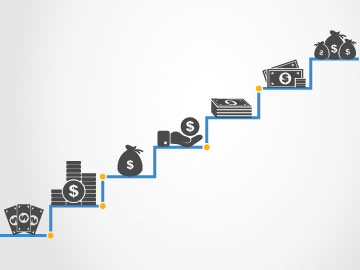
With only a few years to go until retirement, you need to start looking at how you’ll start taking money out of your portfolio.
While you need to stay invested to meet future spending targets, you may not be comfortable with the risk needed to fund all your lifestyle goals.
In cases where a RRIF, pension, CPP and OAS will cover the majority of your spending needs, there’s an easy solution to ensuring you have an acceptable supply of spendable cash. And it won’t ding your non-registered portfolio too hard to set it up. (This example presumes $620,000 in non-registered savings, and an additional $1,000 monthly needed to cover spending, but it can be done with less).
Here’s what to do:
- Fill 10 buckets, each with a year’s worth of safe investments ($12,000)
- Bucket for Year 1: investment savings account
- Buckets for Years 2-4: GIC or another investment savings account
- Buckets for Years 5-10: GIC, investment savings account and/or bonds
As each year ends, the next year’s bucket is activated to pay for the new year’s spending. This covers essentials.
Money not needed for 10 years goes into a reserve bucket and remains in equities, bonds and cash based on risk tolerance.
*Bonds are set to mature when money is needed.
Keeping income consistent
One wealth advisor notes equity portfolios often don’t produce consistent monthly or quarterly income streams. Someone could see more than $20,000 in some months and only a couple thousand in others. This is because income from bonds and dividends gets paid out at different times. Some companies pay quarterly dividends, others monthly. Bonds pay out at set maturity and coupon dates.
Some people don’t mind the uneven payments. “We give them a report at the beginning of the year and they’ll plan their cash flow based on that,” she says.
But others want consistency and ask her to structure cash flow to mimic a pension plan. For these folks, she funnels the income to the cash portion of the portfolio and distributes it in even amounts month-to-month based on income needs.
Not everyone has to dip into the principle when starting to draw down, and she notes those who do express reluctance. They become uncomfortable when they see withdrawals reducing their net worth, so she reminds them this is exactly what they’ve been planning for.
“I draw them a little hill and say, ‘You’ve spent your working career building up your savings and the whole reason they’re there is to draw them down,’ and that’s the downward slope on the hill.”

